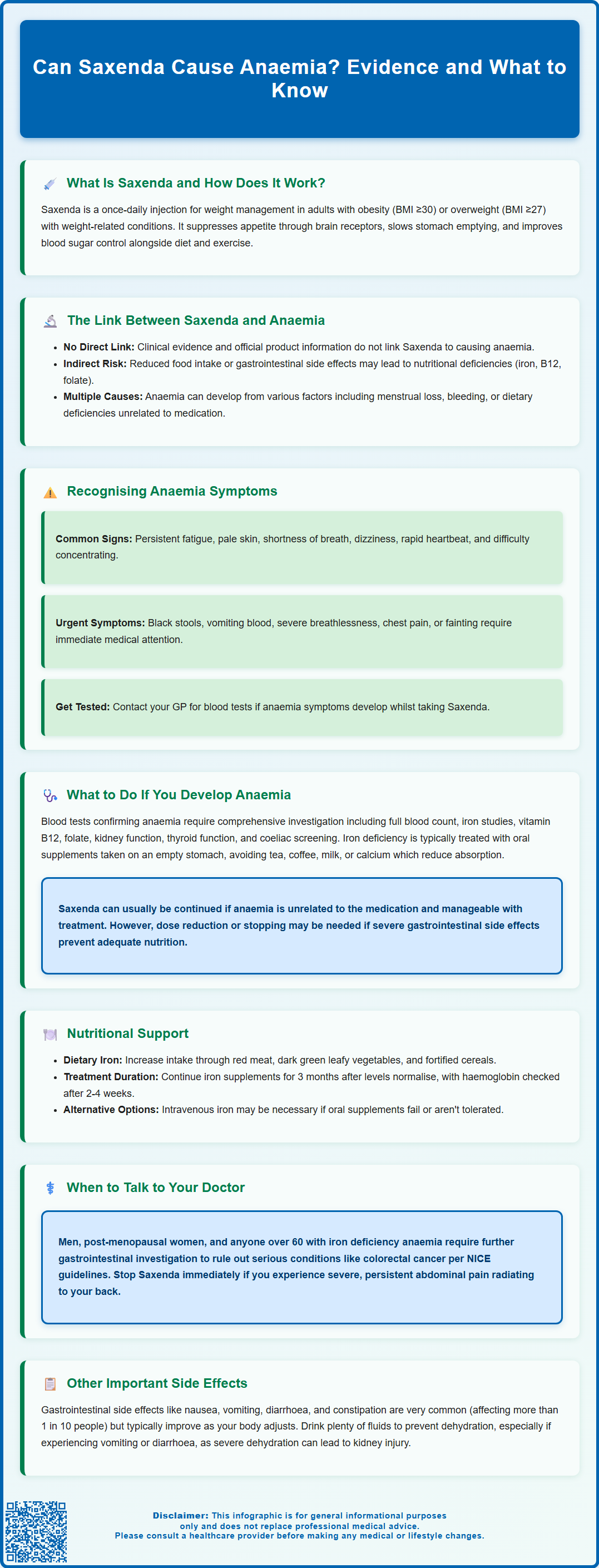Mounjaro®
Dual-agonist support that helps curb appetite, hunger, and cravings to drive substantial, sustained weight loss.
- ~22.5% average body weight loss
- Significant weight reduction
- Improves blood sugar levels
- Clinically proven weight loss

Can Saxenda cause anaemia? This is a common concern among patients prescribed liraglutide 3.0 mg for weight management. Saxenda, a glucagon-like peptide-1 (GLP-1) receptor agonist, is licensed in the UK for adults with obesity or overweight with weight-related comorbidities. Whilst current clinical evidence does not establish a direct link between Saxenda and anaemia development, patients may experience dietary changes and gastrointestinal side effects that could theoretically affect nutritional status. Understanding the relationship between Saxenda treatment and potential anaemia risk is essential for safe, effective weight management under medical supervision.
Summary: Current clinical evidence does not establish a direct link between Saxenda (liraglutide) and the development of anaemia.
Saxenda (liraglutide 3.0 mg) is a prescription-only medicine licensed in the UK for weight management in adults with obesity (BMI ≥30 kg/m²) or overweight (BMI ≥27 kg/m²) with at least one weight-related comorbidity, such as type 2 diabetes, hypertension, or dyslipidaemia. It is administered as a once-daily subcutaneous injection and should be used alongside a reduced-calorie diet and increased physical activity.
Liraglutide belongs to a class of medications called glucagon-like peptide-1 (GLP-1) receptor agonists. It works by mimicking the action of GLP-1, a naturally occurring hormone released from the gut after eating. The mechanism of action involves several pathways:
Appetite suppression: Liraglutide acts on receptors in the brain's appetite centres, particularly the hypothalamus, reducing feelings of hunger and increasing satiety after meals.
Delayed gastric emptying: The medication slows the rate at which food leaves the stomach, prolonging the feeling of fullness.
Improved glycaemic control: Although Saxenda is primarily used for weight management, it also enhances insulin secretion in response to elevated blood glucose and suppresses inappropriate glucagon release.
Clinical trials have demonstrated that Saxenda, when combined with lifestyle modifications, can lead to clinically significant weight loss. The medication is started at a low dose (0.6 mg daily) and gradually increased weekly to the target dose of 3.0 mg daily to improve tolerability.
Saxenda contains the same active ingredient as Victoza (liraglutide 1.8 mg), which is licensed for type 2 diabetes management, but at a higher dose specifically for weight management. These products are not interchangeable. According to the Saxenda Summary of Product Characteristics (SmPC), treatment should be discontinued if patients do not lose at least 5% of their initial body weight after 12 weeks on the 3.0 mg dose.
Importantly, Saxenda is contraindicated during pregnancy and breastfeeding and is not indicated for use in people under 18 years of age.

There is no established link between Saxenda and the development of anaemia based on current clinical evidence. The Saxenda Summary of Product Characteristics (SmPC) does not list anaemia among the known adverse effects of liraglutide. However, patients taking Saxenda for weight management may experience changes in their dietary intake and nutritional status that could theoretically affect red blood cell production.
Anaemia is a condition characterised by a reduction in haemoglobin concentration or red blood cell count, leading to decreased oxygen-carrying capacity of the blood. Common symptoms of anaemia include:
Persistent tiredness and fatigue
Pallor (pale skin, mucous membranes, or conjunctivae)
Shortness of breath, particularly on exertion
Dizziness or light-headedness
Palpitations or rapid heartbeat
Headaches and difficulty concentrating
Patients using Saxenda who experience significant dietary restriction or gastrointestinal side effects (such as nausea, vomiting, or diarrhoea) may be at risk of nutritional deficiencies, including iron, vitamin B12, or folate deficiency, which can contribute to anaemia. Additionally, rapid weight loss itself can sometimes unmask underlying nutritional deficiencies that were previously compensated.
Seek urgent medical attention if you experience:
Black or tarry stools or vomiting blood (signs of gastrointestinal bleeding)
Severe breathlessness or chest pain
Fainting or severe dizziness
If you develop symptoms suggestive of anaemia whilst taking Saxenda, it is important to contact your GP for assessment. Your doctor may arrange blood tests including a full blood count (FBC), iron studies, vitamin B12, and folate levels to determine the cause. It is essential not to self-diagnose or assume that Saxenda is directly responsible, as anaemia has numerous potential causes including menstrual blood loss, gastrointestinal bleeding, chronic disease, or dietary insufficiency unrelated to the medication.
If blood tests confirm anaemia whilst you are taking Saxenda, your healthcare team will work to identify and address the underlying cause. Management will depend on the type and severity of anaemia identified, as well as any contributing factors related to your weight management programme.
Initial assessment and investigation should include:
Full blood count (FBC): To determine haemoglobin level, mean corpuscular volume (MCV), and red blood cell indices
Iron studies: Serum ferritin, serum iron, transferrin saturation, and total iron-binding capacity
Vitamin B12 and folate levels: To exclude deficiency anaemias
Renal function tests: As chronic kidney disease can cause anaemia
Thyroid function: Hypothyroidism can contribute to anaemia
Coeliac serology: Testing for coeliac disease is recommended in cases of unexplained iron deficiency anaemia
If iron deficiency anaemia is identified, oral iron supplementation (such as ferrous sulphate, ferrous fumarate or ferrous gluconate) is typically first-line treatment. Take iron supplements on an empty stomach or 1 hour before meals if possible, and avoid taking with tea, coffee, milk or calcium supplements which can reduce absorption. Lower doses or alternate-day dosing may be recommended to improve tolerability and absorption. Your doctor will check your haemoglobin response within 2-4 weeks and typically continue treatment for about 3 months after your haemoglobin normalises to replenish iron stores.
Dietary advice to increase iron-rich foods is also important, including red meat, dark green leafy vegetables, and fortified cereals. If oral iron is not tolerated or effective, intravenous iron may be considered.
Your prescriber will need to review whether Saxenda should be continued. In most cases, if the anaemia is unrelated to the medication itself and can be managed with appropriate treatment, Saxenda may be continued under close monitoring. However, if severe gastrointestinal side effects are preventing adequate nutritional intake, dose reduction or discontinuation may be necessary.
For men and post-menopausal women with iron deficiency anaemia, and for people aged 60 or over with iron deficiency anaemia, further investigation of the gastrointestinal tract may be recommended to exclude underlying causes such as colorectal cancer, in line with NICE guidance (NG12).
Saxenda, like all medications, can cause side effects, although not everyone experiences them. Understanding the common and serious adverse effects helps patients recognise when medical attention is needed.
Very common gastrointestinal side effects (affecting more than 1 in 10 people) include:
Nausea and vomiting: Usually most pronounced when starting treatment or increasing the dose
Diarrhoea or constipation: Gastrointestinal motility changes are frequent
Dyspepsia: Indigestion and upper abdominal discomfort
These effects often improve over time as the body adjusts to the medication. Starting at a low dose and gradually titrating upwards, as per the prescribing schedule, helps minimise gastrointestinal symptoms.
Other common side effects include:
Hypoglycaemia (low blood sugar), particularly in patients also taking other glucose-lowering medications (less common in non-diabetic patients)
Injection site reactions (redness, itching, or bruising)
Headache and dizziness
Fatigue
Increased heart rate (tachycardia)
Serious side effects requiring immediate medical attention include:
Acute pancreatitis: Severe, persistent abdominal pain radiating to the back, often accompanied by vomiting. Stop taking Saxenda and seek urgent medical attention if you experience these symptoms.
Gallbladder disease: Saxenda may increase the risk of cholelithiasis (gallstones) and cholecystitis.
Severe allergic reactions: Anaphylaxis, though rare, requires emergency treatment.
Acute kidney injury: Particularly in patients experiencing severe vomiting and diarrhoea leading to dehydration.
Suicidal ideation: Rare reports exist; patients with mood changes should seek urgent medical advice.
Patients should be counselled about dehydration risk due to gastrointestinal side effects and advised to maintain adequate fluid intake. The SmPC advises caution in patients with thyroid disease, but routine calcitonin monitoring is not required. Saxenda is contraindicated during pregnancy and breastfeeding, so effective contraception should be used during treatment.
If you experience any side effects, talk to your doctor, pharmacist or nurse. This includes any possible side effects not listed in the package leaflet. You can also report side effects directly via the Yellow Card Scheme at yellowcard.mhra.gov.uk or search for MHRA Yellow Card in the Google Play or Apple App Store.
No, anaemia is not listed as a known adverse effect in the Saxenda Summary of Product Characteristics. However, dietary changes and gastrointestinal side effects during treatment may theoretically affect nutritional status and contribute to deficiency anaemias.
Contact your GP for assessment if you experience persistent tiredness, pallor, breathlessness, or dizziness. Your doctor will arrange blood tests including full blood count, iron studies, and vitamin B12 and folate levels to determine the cause and appropriate treatment.
In most cases, if anaemia is unrelated to Saxenda itself and can be managed with appropriate treatment, the medication may be continued under close monitoring. Your prescriber will review your individual circumstances and may consider dose reduction or discontinuation if severe gastrointestinal side effects prevent adequate nutritional intake.
The health-related content published on this site is based on credible scientific sources and is periodically reviewed to ensure accuracy and relevance. Although we aim to reflect the most current medical knowledge, the material is meant for general education and awareness only.
The information on this site is not a substitute for professional medical advice. For any health concerns, please speak with a qualified medical professional. By using this information, you acknowledge responsibility for any decisions made and understand we are not liable for any consequences that may result.
Lorem ipsum dolor sit amet, consectetur adipiscing elit, sed do eiusmod tempor incididunt ut labore et dolore magna aliqua. Ut enim ad minim veniam, quis nostrud exercitation ullamco laboris nisi ut aliquip ex ea commodo consequat. Duis aute irure dolor in reprehenderit in voluptate velit esse cillum dolore eu fugiat nulla pariatur.
Block quote
Ordered list
Unordered list
Bold text
Emphasis
Superscript
Subscript